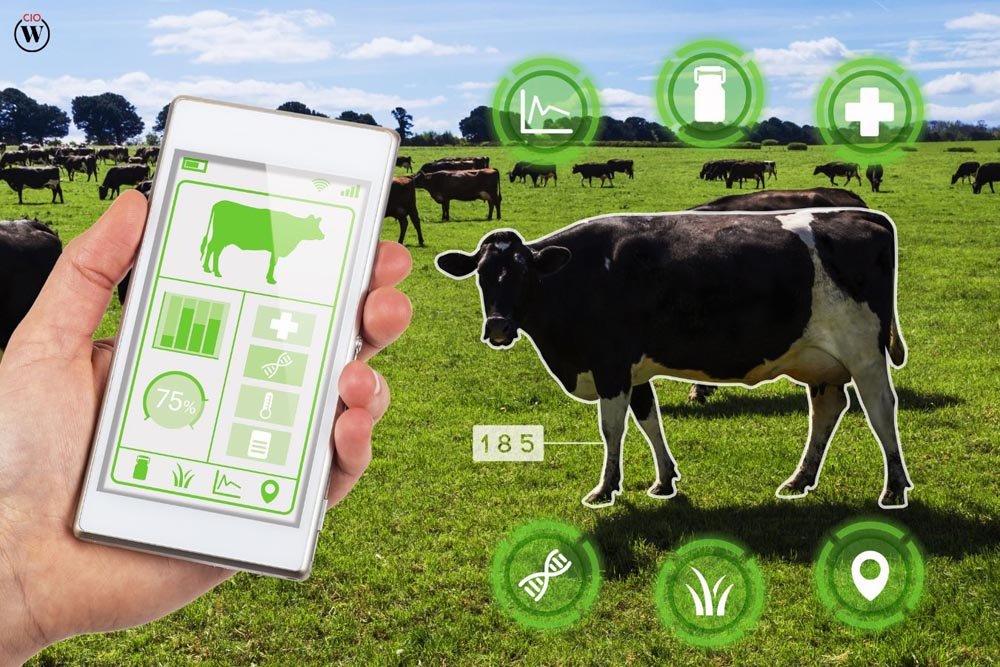The farming industry has changed a lot over the years. We’ve moved from doing everything by hand to using machines to make farming easier and more efficient. Now, the newest change is the use of AI in livestock management. AI is set to revolutionize livestock management, making it more accurate, efficient, and sustainable. In this article, we’ll look at how AI is being used in livestock management and how it’s shaping the future of farming.
Precision Livestock Farming
Precision livestock farming (PLF) involves the use of technology to monitor and manage livestock. AI in livestock management plays a crucial role in PLF by providing real-time data and insights. Sensors, cameras, and drones collect data on various aspects of livestock health and behavior, which AI algorithms analyze to provide actionable insights. This allows farmers to make informed decisions, ensuring the well-being of their animals and improving overall farm productivity.
Health Monitoring and Disease Prevention
One of the most significant benefits of AI in livestock management is its ability to monitor animal health continuously. Wearable devices and smart collars equipped with sensors track vital signs such as heart rate, temperature, and activity levels. AI algorithms analyze this data to detect early signs of illness, stress, or discomfort. For instance, changes in a cow’s rumination patterns can indicate digestive issues, while increased body temperature might signal an infection.

Early detection of health issues enables farmers to intervene promptly, reducing the risk of disease outbreaks and minimizing the need for antibiotics. This not only ensures the well-being of the animals but also contributes to food safety and public health.
Optimizing Feeding Practices
AI in livestock management also extends to optimizing feeding practices. Automated feeding systems equipped with AI can analyze the nutritional needs of each animal based on factors such as age, weight, and health status. These systems can then dispense the appropriate amount and type of feed, ensuring that each animal receives a balanced diet.
Additionally, AI can predict the optimal times for feeding and adjust feed distribution based on weather conditions, reducing waste and improving feed efficiency. This precision feeding not only enhances animal growth and productivity but also reduces the environmental impact of farming by minimizing resource use.
Enhancing Reproductive Management
Reproductive management is another area where AI in livestock management is making a significant impact. AI-powered systems can monitor reproductive indicators such as heat cycles and ovulation in real-time. For example, changes in an animal’s behavior, such as increased movement or restlessness, can indicate that it is in heat.
By accurately predicting the best time for breeding, AI helps farmers achieve higher conception rates and improve the genetic quality of their herds. This leads to more efficient reproduction and better overall herd performance.
Automating Routine Tasks
AI in livestock management is also helping to automate routine tasks, reducing the labor burden on farmers. For instance, robotic milking systems equipped with AI can identify individual cows, position the milking cups accurately, and monitor milk quality in real-time. These systems can operate around the clock, increasing milking efficiency and freeing up farmers to focus on other essential tasks.
Similarly, AI-powered cleaning robots can maintain hygiene in barns and pens by automatically detecting and removing waste. This not only ensures a clean and healthy environment for the animals but also reduces the risk of disease transmission.
Predictive Analytics for Better Decision-Making
Predictive analytics is a powerful tool in AI in livestock management. By analyzing historical data and current trends, AI can provide farmers with valuable forecasts and recommendations. For example, AI can predict future milk production based on factors such as feed quality, weather conditions, and herd health. This enables farmers to plan their operations more effectively and make data-driven decisions.

AI can also provide insights into market trends, helping farmers optimize their production schedules and pricing strategies. By staying ahead of market fluctuations, farmers can maximize their profits and ensure the sustainability of their operations.
Improving Animal Welfare
Animal welfare is a critical aspect of livestock management, and AI is playing a significant role in enhancing it. AI-powered systems can monitor animal behavior and detect signs of distress, pain, or discomfort. For example, changes in posture or vocalization patterns can indicate that an animal is in pain or experiencing stress.
By identifying these issues early, farmers can take appropriate measures to alleviate the animals’ discomfort and improve their overall well-being. This not only ensures ethical treatment of the animals but also contributes to better farm productivity and profitability.
Environmental Sustainability
Sustainable farming practices are essential for the future of agriculture, and AI in livestock management is helping to achieve this goal. AI can optimize resource use, reduce waste, and minimize the environmental impact of farming. For example, precision feeding reduces the amount of feed needed, lowering the carbon footprint of livestock production.
AI can also help manage manure and waste more effectively, reducing greenhouse gas emissions and preventing pollution. By promoting sustainable practices, AI is contributing to the long-term viability of livestock farming and protecting the environment for future generations.
Challenges and Considerations
While the benefits of AI in livestock management are significant, there are also challenges and considerations that need to be addressed. One of the primary challenges is the cost of implementing AI technologies. Many small and medium-sized farms may find it difficult to afford the initial investment in AI systems and equipment.
Additionally, there is a need for technical expertise to operate and maintain AI systems effectively. Farmers may require training and support to fully leverage the potential of AI in livestock management. Ensuring data privacy and security is also crucial, as the extensive use of sensors and data collection raises concerns about the protection of sensitive information.
The Future of AI in Livestock Management
The future of AI in livestock management looks promising, with continuous advancements in technology and increasing adoption by farmers. As AI systems become more affordable and accessible, more farms will be able to benefit from their capabilities. Integration with other emerging technologies, such as the Internet of Things (IoT) and blockchain, will further enhance the potential of AI in livestock management.

IoT devices can provide additional data points for AI analysis, while blockchain can ensure transparency and traceability in the supply chain. Together, these technologies will enable more efficient, sustainable, and ethical livestock management practices.
Conclusion
AI in livestock management is changing how farmers work, offering many benefits in efficiency, productivity, and sustainability. AI helps with health monitoring, disease prevention, optimizing feeding, and improving breeding. It makes livestock farming more precise and data-driven. By automating routine tasks and providing predictive insights, AI helps farmers make better decisions and improve animal welfare. Despite some challenges, the future of AI in livestock management looks promising. It has the potential to revolutionize farming and ensure sustainability for future generations. Embracing AI in livestock management is not just about new technology; it’s a step towards a more efficient, ethical, and sustainable future in agriculture.









